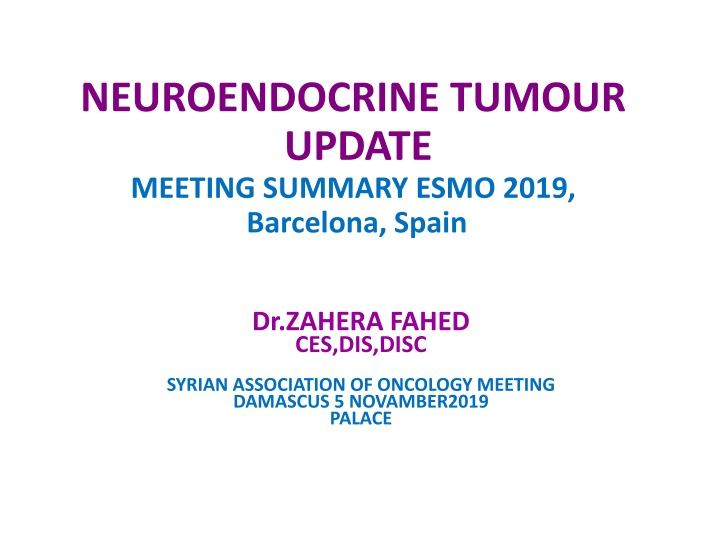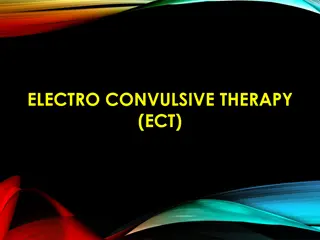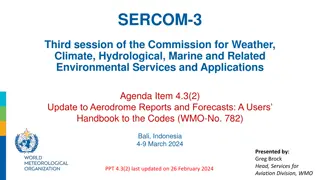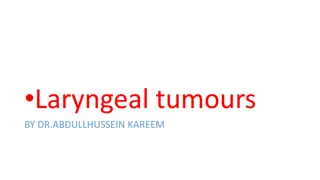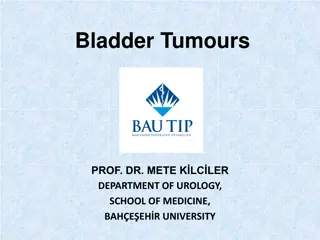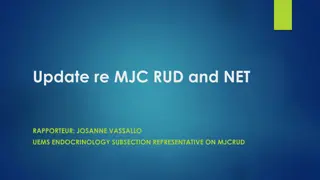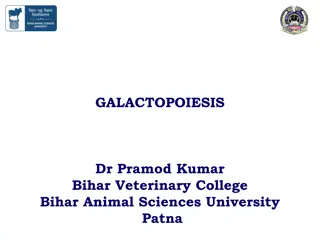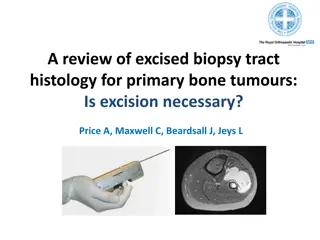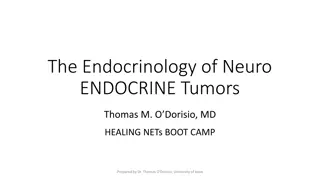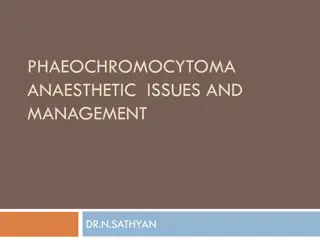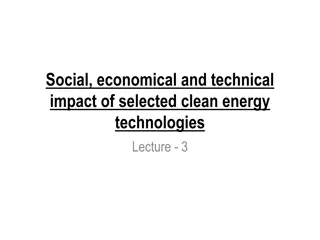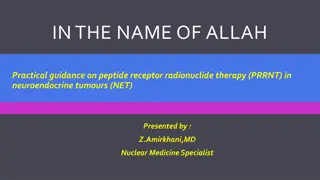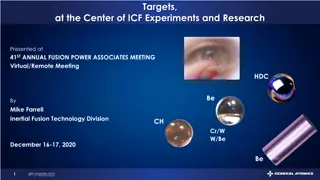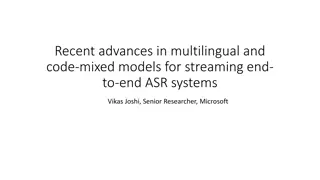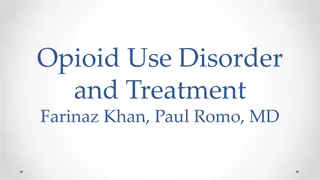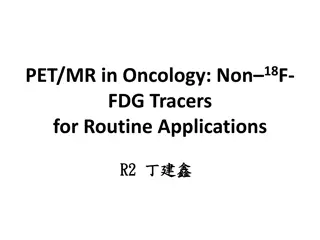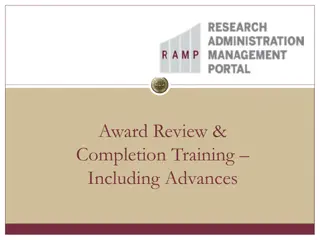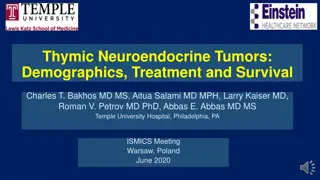Advances in Neuroendocrine Tumours: ESMO 2019 Update
Update from the ESMO 2019 meeting in Barcelona focusing on neuroendocrine tumors (NETs). Highlighting challenges in diagnosis and treatment, including limited knowledge and late diagnosis. Discusses different types of NETs, prevalence, approved therapeutic options, and key trials presented at the conference. Special emphasis on the SANET-ep study investigating the efficacy of surufatinib in well-differentiated extra-pancreatic NETs.
Download Presentation

Please find below an Image/Link to download the presentation.
The content on the website is provided AS IS for your information and personal use only. It may not be sold, licensed, or shared on other websites without obtaining consent from the author.If you encounter any issues during the download, it is possible that the publisher has removed the file from their server.
You are allowed to download the files provided on this website for personal or commercial use, subject to the condition that they are used lawfully. All files are the property of their respective owners.
The content on the website is provided AS IS for your information and personal use only. It may not be sold, licensed, or shared on other websites without obtaining consent from the author.
E N D
Presentation Transcript
NEUROENDOCRINE TUMOUR UPDATE MEETING SUMMARY ESMO 2019, Barcelona, Spain Dr.ZAHERA FAHED CES,DIS,DISC SYRIAN ASSOCIATION OF ONCOLOGY MEETING DAMASCUS 5 NOVAMBER2019 PALACE
Introduction to NET Diagnostic & therapeutic challenges NET are relatively rare; this is associated with limited knowledge on disease management The natural history of NET is poorly understood At least 40 different entities arising in different organs; different terminologies and classifications Heterogeneous group of tumors Wide variety of clinical presentations Late presentation Over 60% of NETs are advanced at the time of diagnosis The median survival for patients with advanced NET is 33 months Histologic diagnosis may be difficult Variety of therapeutic options/approaches Limited phase III evidence for chemotherapy and PRRT Pancreatic NETs Insulinoma Glucagonoma VIPoma Pancreatic polypeptidoma
NETs Are Second Most Prevalent Gastrointestinal Tumor
APPROVED THERAPEUTIC OPTIONS IN NEUROENDOCRINE TUMOURS
Main 3 Trials NEUROENDOCRINE TUMOUR PRESENTATIONS AT ESMO 2019
SANET-ep: A PHASE III STUDY OF SURUFATINIB IN PATIENTS WITH WELL DIFFERENTIATED ADVANCED EXTRAPANCREATIC NET Xu, et al. ESMO 2019 Abstract #LBA76
BACKGROUND surufatinib is an anti-angiogenic TKI that selectively inhibits VEGFR, FGFR &CSF-1R Anti-VEGF signaling pathway is a proven strategy for treatment of pancreatic NETs but its effect in extra- pancreatic NETs has yet to be proven SANET-ep investigates the effect of surufatinib in patients with advanced, well differentiated extra- pancreatic NETs CSF-1R, colony stimulating factor-1 receptor; FGFR, fibroblast growth factor receptor; NET, neuroendocrine tumour; VEGF(R), vascular endothelial growth factor (receptor) 1. Raymond E, et al. N Engl J Med 2011;364:501 13;2. Xu J, et al. Presented at ESMO 2019. Abstract #LBA76
SANET-epSTUDY DESIGN PROGRESSIVE ADVANCED EXTRA PROGRESSIVE ADVANCED EXTRA- -PANCREATIC NET PATIENTS PANCREATIC NET PATIENTS Tumour origin: A, jejunum; ileum, duodenum, thymus, cecum; B: lung, stomach, liver, appendix, colon, rectum; C: other or unknown. Study was terminated due to superiority following a pre- planned interim analysis at 127 PFS event DCR, disease control rate; DoR, duration of response; NET, neuroendocrine tumours; ORR, objective response rate; OS, overall survival; PD, progressive disease; PFS, progression-free survival; TTR, time to tumour response Xu J, et al. Presented at ESMO 2019. Abstract #LBA76
SANET-epPRIMARY ENDPOINT RESULTS PROGRESSION FREE SURVIVAL (INVESTIGATOR ASSESSED) PFS 9.2 months (surufatinib) vs 3.8 months (placebo) CI, confidence interval; HR, hazard ratio; PFS, progression free survival Xu J, et al. Presented at ESMO 2019. Abstract #LBA76 SANET-epPRIMARY ENDPOINT RESULTS PFS 9.2 months (surufatinib) vs 3.8 months (placebo)
SUMMARY Surufatinib significantly improved PFS in patients with advanced extra-pancreatic NETs1 One limitation of the SANET-ep study is that it was conducted in an Asian population only A poster presentation at ESMO 2019 reported on the safety profile of surufatinib in solid tumours in a western population The safety profile in the western population was shown to be similar to that reported in the Asian population Further data is required in a western population before implementing in clinical practice However, this is a step forward in delivering new options for patients with NETs NET, neuroendocrine tumours 1. Xu J, et al. Presented at ESMO 2019. Abstract #LBA76 ; 2. Hamilton E, et al. Presented at ESMO 2019. Abstract #1393P
NETTER-1 (POST HOC ANALYSIS): RELATION BETWEEN OBJECTIVE TUMOUR SHRINKAGE AND PFS Pavel, et al. ESMO 2019 Abstract #1382PD
BACKGROUND NETTER-1 investigated the effect of 177Lu-DOTATATEplus octreotide in patients with progressive midgut NETs1 The NETTER-1 trial was instrumental in PRRT now being part of the treatment pathway for patients with NET Treatment efficacy has often been associated with early reduction of tumour size This post-hoc analysis of NETTER-1 examined whether achieving objective tumour shrinkage predicts duration of PFS Lu, lutetium; NET, neuroendocrine tumour; PFS, progression free survival; PRRT, peptide receptor radionuclide therapy 1. StrosbergJ. NEJM 2017; 376:125-35; 2. Pavel M. ESMO 2019 Abstract #1382PD
NETTER-1 PHASE III TRIAL MAIN STUDY DESIGN Primary post hoc analysis for tumourshrinkage was based on the time interval between baseline and 150 days from baseline and conducted on the full analysis set of229 patients GBq, gigabecquerels; LAR, long acting release; Lu, lutetium; RECIST, response evaluation criteria in solid tumors Strosberg J. NEJM 2017;376:125- 35
NETTER-1 (POST-HOC ANALYSIS) PFS IN RELATION TO TUMOUR RESPONSE IN THE 177Lu-DOTATATE GROUP PFS, progression free survival Pavel, M. ESMO 2019 Abstract #1382PD
SUMMARY All patients benefitted from treatment with PRRT regardless of tumour shrinkage Benefit of 4 cycles of PRRT treatment should not only be assessed by tumour shrinkage PRRT, peptide receptor radionuclide therapy Pavel M. ESMO 2019 Abstract #1382PD
HEPAR PLUS: A PHASE 2 OPEN LABEL STUDY OF 177LU-DOTATATE PLUS 166HO-RADIOEMBOLISM IN PATIENTS WITH NETs Braat, et al. ESMO 2019 Abstract #1380O
BACKGROUND At diagnosis 21% of the patients with a grade 1 NET and 30% with a grade 2 NET have distant metastases1 The liver is the most commonly affected organ in metastatic disease and is the most incriminating factor for patient survival1 Treatment with peptide receptor radionuclide therapy (PRRT) shows a high objective response rate and long median survival after treatment However, complete remission is almost never achieved1,2 Additional treatment of liver disease after PRRT may improve outcome in NET patients2 Radioembolization is an established therapy for liver metastasis NET, neuroendocrine tumour; PRRT, peptide receptor radionuclide therapy 1. BraatA, et al. BMC Gastroenterology 2018;18:84; BraatA, et al. ECIO 2019 Abstract #1902.3
HEPAR PLUS STUDY DESIGN Non-randomised, single arm, phase 2 study 34 patients included 31 patients treated 30 patients evaluable Primary objectives: objective response rate (RECIST 1.1) 3 months after 166Ho-RE Secondary endpoints: toxicity profile, biochemical response, QoL, biodistribution and dosimetry QoL, quality of life; RE, radioembolization BraatA, et al. BMC Gastroenterology 2018;18:84; BraatA, et al. Presented at ESMO 2019 Abstract #1380O
SUMMARY HEPAR PLUS is the first trial in this setting and suggests that radioembolization after treatment with PRRT may benefit patients with NETs Promising results seen from HEPAR PLUS but must be confirmed in a randomisedphase 3 trial
